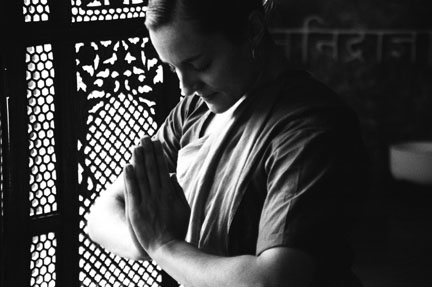
"Lord, I offer to you humbly both myself and my art."





 |
| Tanjore Balasaraswati also known as Srimati Balasaraswati (13 May 1918 - 9 February 1984) was a celebrated Indian dancer, musician and lineage holder for the ancient Tanjore tradition of Bharata Natyam. Her arangetram (ceremonial debut performance) took place in Kanchipuram, India in 1925. Balasaraswati was a seventh generation representative of a traditional marilineal family of musicians and dancers who have been described as the greatest single repository of the traditional performing arts of music and dance of the southern region of India [("Balasaraswati" by V.K. Narayana Menon)]. Poet Gary Snyder described seeing her as, "... an exemplar and teacher of the wholeness of dance. In spite of the temporizers of Madras who tried to excise the sensual element from dance, she always insisted on the authenticity and dignity of the erotic component. She was a true yogini of dance. While still in her youth, hampered by ill-health, feeling misunderstood, it became her deep wish to dance before Shiva, or Murugan, in the temple of Tiruttani. Entering the inner chamber, bribing the watchman, breaking the law, she danced in solitude saying "Lord, I offer to you humbly both myself and my art." |
|
|
 |
| Srimati Shyamala, founder of The Koothambalam School, and a master of the Balasaraswati tradition of Bharata Natyam, started dancing at the age of seven and at the age of fourteen began her studies with the legendary dance master Srimati T. Balasaraswati. Shyamala received her 'Diploma of Proficiency' and had her Arangetram (ceremonial first performance) in 1978. She taught, performed and lectured extensively with extraordinary generosity and skill, sharing the sublime depth and beauty of the temple arts of South India. |
|
|

|
| Laurissa Vibhuti currently serves as the director of The Koothambalam School of Bharatanatyam (Indian Dance) located in Longmont, Co. Laurissa began formal ballet training at the age of four, at the age of 15 she turned her attention towards Hatha Yoga, bharatanatyam, and Sanskrit which she studied both in the U.S. and India. She has learned traditional bharatanatyam with her dance guru, Srimati Shyamala, a master of the Balasaraswati Style. In 2004 Laurissa completed her arangetram (ceremonial debut performance). This momentous and intensive period of study and practice culminates in a formal 2 hour solo dance offering. It is a profound rite of passage that deepens the dancer's devotion and dedication to her guru, to her lineage and the divine, she is the only non-Indian to have completed the formal arangetram margam (sequence or path) in her teacher's lineage. |

|
| Neela Bhaskar is a Bharatanatyam dancer in the distinct tradition of T. Balasaraswati. Her teacher (late, 2015), Shyamala Mohanraj, was a direct disciple of T. Balasaraswati herself. As this tradition emphasizes musicality, Neela is also a trained Carnatic vocalist from several teachers, many of whom specialized in singing for dance. Offstage, Neela is a passionate teacher of dance and a research scholar of Tamil literature, having completed her PhD (2023) on 19th century Tamil prose literature. She is currently working on editing and translating a technical medieval commentary to the famous Tamil epic Cilappatikāram. This commentary deals with several dance- and music- related concepts. Neela performs actively in Germany, where she lives and continues to learn and teach both dance and music. |
|
|
 |
| Sonja Radvila has studied Bharata Natyam with Shyamala Mohraj and Laurissa Vibhuti in Chennai and Boulder, and participated in many lecture demonstrations and performances. She is a long-time, dedicated practitioner of Ashtanga Yoga. Sonja has a deep respect for the wisdom and importance of listening to the body while reaching beyond familiar boundaries. She brings to her dance a deeply committed sincerity and elegance. |
|
|
 |
| Romona Mukherjee has been a student at the Koothambalam School of Bharata Natyam since age 10, and completed her arrangetram in 2003. She currently lives and teaches in California. Romona found her dharma as a dancer at a very early age, her performances reflect her highly disciplined yet gentle presence. With a cheerful willingness to freely share her deep reverence and gratitude for the Srimati Balasaraswti Tradition, Romona teaches all levels of students. |